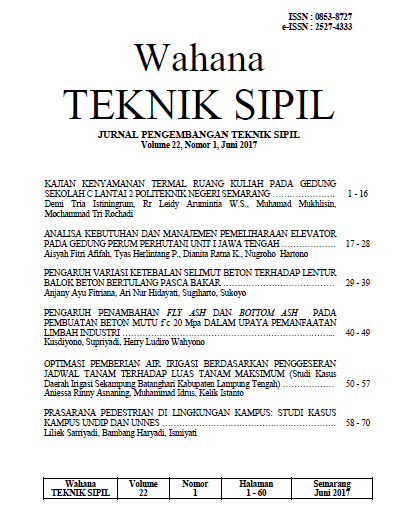Optimasi Pemberian Air Irigasi Berdasarkan Penggeseran Jadwal Tanam Terhadap Luas Tanam Maksimum (Studi Kasus Daerah Irigasi Sekampung Batanghari Kabupaten Lampung Tengah)
DOI:
https://doi.org/10.32497/wahanats.v22i1.900Abstract
Sekampung Batanghari Irrigation Area is one of the irrigation areas whose water supply comes from Argoguruh Dam. Lack of water discharge on weirs causes the cultivated area to be limited. The problem of water shortage needs to be given optimization solution of water distribution so that the area can be planted to maximum and can increase rice production.. Optimization analysis of channel in Sekampung Batanghari Irrigation Area was done using linear programming method by initial shifting cultivation in the first planting season when the availability of discharge in the channel was abundant with rice-rice-rice cropping pattern for three times of planting season. The optimization results that have been done by shifting the beginning of planting in January, February, May, August, and November show that the maximum plantable area that can be cultivated is 1,823.77 hectares per year that is on the initial shifting of the first planting season in January or May with intensity planting of 230%. While the minimum planting area that can be planted is 1,062.71 hectares per year on the initial shift of the first planting season in November.
Kata kunci : optimization, irrigation, planting season
Downloads
Published
Issue
Section
License
Authors who publish with this journal agree to the following terms:Authors retain copyright and grant the journal right of first publication with the work simultaneously licensed under a Creative Commons Attribution License that allows others to share the work with an acknowledgement of the work's authorship and initial publication in this journal.
Authors are able to enter into separate, additional contractual arrangements for the non-exclusive distribution of the journal's published version of the work (e.g., post it to an institutional repository or publish it in a book), with an acknowledgement of its initial publication in this journal.
Authors are permitted and encouraged to post their work online (e.g., in institutional repositories or on their website) prior to and during the submission process, as it can lead to productive exchanges, as well as earlier and greater citation of published work (See The Effect of Open Access).






